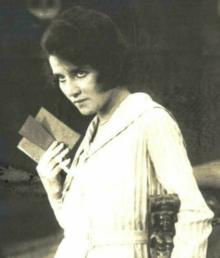Gertrud Kanitz
Gertrud Kanitz | |
|---|---|
 Kanitz c. 1918 | |
| Born | |
| Died | January 15, 1943 |
| Occupation | Actress |
| Years active | 1918-1931 |
Gertrud Reif Kanitz (died January 15, 1943)[1] was an Austrian actress in German language films and theatre in the 1910s and 1920s. Her family fled from their home country to the United States in 1938 when the Anschluss began.
Career
[edit]Raised in Vienna, Austria, Kanitz attended Max Reinhardt's acting school and debuted on the stage as Snow White in fairy tale plays during the winter of 1916 in Hamburg.[2] She later lived with her husband and children in a rural area of Austria where she taught a school classroom for students from varying countries. Her husband later established the Vienna Choir, which resulted in them traveling between their town and Vienna. In March of 1938, while they were back in their rural village, the family was informed about the Anschluss occurring in Vienna. Thet fled to America in June 1938.[3]
Filmography
[edit]- Shadows of the Night (German: Schatten der Nacht) (1918)[4]
- Father and Son (German: Vater und Sohn) (1918)
- The Laughing Death (German: Der lachende Tod) (1918)
- The Wandering Eye (German: Das wandernde Auge) (1919)
- The Duke of Reichstadt (German: Der Herzog von Reichstadt) (1931)
Theatre
[edit]- Die selige Excellenz (1921) as Helga[5]
- Satyros (1922) as Psyche[6]
- Miß Sara Sampson (1922) as Gretchen[7]
- Zärtlichen Verwandten (1924)[8]
- König Hunger (1924) as the girl in black[9]
- Narrenliebe (1926)[10]
Personal life
[edit]Kanitz was married to music professor, Dr. Ernest Kanitz. He tuaght at Winthrop College and then Erskine College. She died in New York on January 15, 1943 due to an illness. Their home was in South Carolina.[1] They had a son and two daughters. After her death he moved to Los Angeles.[11] The University of Southern California has a collection of his papers.[12]
References
[edit]- ^ a b "Mrs. Gertrude Kanitz". The Greenville News. January 22, 1943. Retrieved October 25, 2024 – via Newspapers.com.
- ^ Hartmut, Binder (1976). "Grundsätzliches zu den Ausdrucksbewegungen" [Basics of expressive movements]. Kafka in neuer Sicht [Kafka in a New Perspective] (in German). J.B. Metzler Stuttgart. pp. 128–129. doi:10.1007/978-3-476-03065-8_4. ISBN 978-3-476-00337-9.
- ^ "Austria As It Once Was". The Bennington Evening Banner. October 12, 1938. Retrieved October 22, 2024 – via Newspapers.com.
- ^ Harf, Stella (January 1918). "Was die "L.B.B." erzählt" [What the "L.B.B." tells us]. Lichtbild-Bühne (in German). Retrieved October 24, 2024.
- ^ Hirsch, Werner (1921). "Deutsches Künstlertheater: 'Die selige Excellenz'" [German Artists' Theater: 'The Blessed Excellency']. Der Kritiker. 3 (9): 11. Retrieved October 22, 2024.
- ^ Behl, C. F. W. (1922). "Lenz und Goethe" [Lenz and Goethe]. Der Kritiker. 4 (1): 8. Retrieved October 22, 2024.
- ^ Behl, C. F. W. (1922). "Miß Sara Sampson" [Miss Sara Sampson]. Der Kritiker. 4 (19): 6–7. Retrieved October 24, 2024.
- ^ Behl, C. F. W. (1924). "Benedix-Renaissance". Der Kritiker. 6 (1): 7. Retrieved October 24, 2024.
- ^ Behl, C. F. W. (1924). "König Hunger" [King Hunger]. Der Kritiker. 6 (4): 2. Retrieved October 24, 2024.
- ^ Behl, C. F. W. (1926). ""Hier wird man geheilt!"" ["Here you get cured!"]. Der Kritiker. 8 (7): 105. Retrieved October 24, 2024.
- ^ https://mediapressmusic.com/composers/kanitz-ernest/
- ^ https://oac.cdlib.org/findaid/ark:/13030/c8zc87g6/admin/
